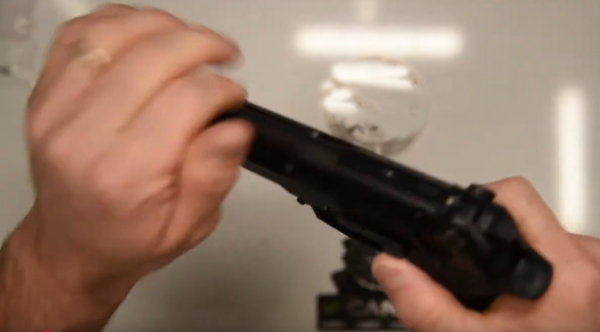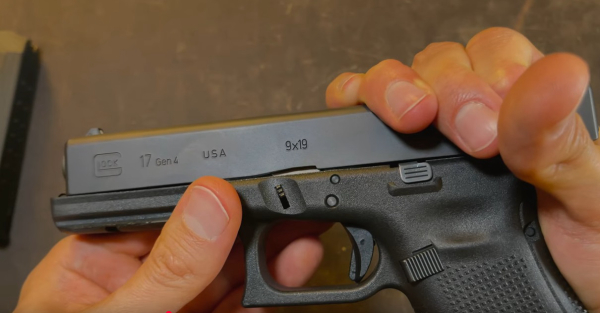The number of times I’ve seen – in person and on video – people manipulate a handgun with the nondominant hand in the vicinity of the muzzle can’t be counted.
Or maybe the loss of recall is age-related memory loss or it’s simply despair.
People I know who clearly know better “clear the pistol, then move to lock the slide back” with a portion of the hand in the blast area, in front of the muzzle.
Wait -- he “cleared” the pistol, so he knows it’s unloaded. Right?

This pair of screenshots, images from videos with identifying marks scrubbed, show the infatuation with having one’s hand over the muzzle. A bad example to set and a poor idea in any event.
No. The most recent case coming to my attention was a story on the internet; a user showed a photo of a person’s left hand. At the base of the palm, near the wrist, to the outside – there was a carbon smudge and a bullet hole. The gun (if it matters – and it doesn’t) was a GLOCK 44, a pistol I have often used.
The user removed the magazine, racked the slide – just as instructed – then put the nondominant hand on the front of the gun preparing to move the slide back for disassembly. The only thing left was to pull the trigger.
This was done, with the resulting blast and stream of verbal excitement (no doubt).
But it was UNloaded!
Sure. That’s why you have the extra body piercing now.
Apparently, the round failed to extract/eject and no one thought it prudent to (1) check that thing visually and physically, and (2) use the armorers’ grip to move the slide back – after directing the muzzle into a safe direction then pulling the trigger.
But it’s so much trouble to go to – like the trip to the Emergency Department of the local hospital.
Rule 2 is predicated on Rule 1.
Rule 2: Never let the muzzle cover anything you don’t intend to destroy. The Safe Direction rule. The “laser” rule. What in your near proximity will stop the bullet without creating enough damage to really matter?
It follows Rule 1: ALL GUNS ARE ALWAYS LOADED. That’s not a range rule, it’s not a “treat every gun blah-blah-blah” nonsense. It’s a statement of absolute fact. If it’s really not loaded … prove it.
Without shooting yourself. Or me.
The failure here, a failure of a loaded round to extract and eject, is hardly common and it’s hardly unheard of. It’s the snake under the rock next to where your keys went when you dropped them. If you reach without looking, nature takes its course.
If you’re lucky, you’ll know better next time. And there will be a next time.
If you’re lucky.
I’ve seen it in armories, gun shops, on ranges and in “let’s put lighter springs in our guns” videos on streaming services.
Keep your hand away from the muzzle.

The “armorer’s grip,” shown above right-handed, below left-handed, is the best way to get that slide back for field-stripping while avoiding proximity to the muzzle.
The reason manufacturers originally put grasping grooves on the rear of pistol slides for so many years is that to put them on the front of the slide puts the hand too near the muzzle.
Muzzle direction follows closely on “All guns are always loaded” for a reason. Jeff Cooper wasn’t just sitting around one day wondering what to write. He was wondering what he could propose to keep us from hurting ourselves and others. Like the Commandments, where all the rules follow two primary rules, his Rules put the primary where it belongs – all guns are always loaded – and followed with “… and for that reason, MIND THE MUZZLE!”
Then there’s the thing that generates the bang – stay clear of the trigger.
And then, even if you intend to shoot – is it really okay to shoot? Is the forward area clear of people? Where does the round go if I miss (or hit, when the target won’t stop the bullet)?
From the story linked above, our Tactical Professor Claude Werner related the following sound advice:
“The correct thing to do is always establish a proper grip and deliberately take a sight picture whenever you press the trigger. It doesn’t matter when, do it at all times. When clearing your pistol at the range, take a sight picture on some particular target and observe what the sights do when you press the trigger. When you have to press the trigger to disassemble the pistol, aim at something that will involve the least amount of “damage to property and/or injury to personnel.””
That’s not only positive safety advice, it’s another rep on GRIP-LOOK-TRIGGER to help form positive shooting habits. It’s something I did at the end of the old deputies’ qualification last weekend – aimed in at that target, after clearing the piece and before scoring, and got another good dry rep in.
In any event, don’t put anything that bleeds in front of the firearm.
— Rich Grassi